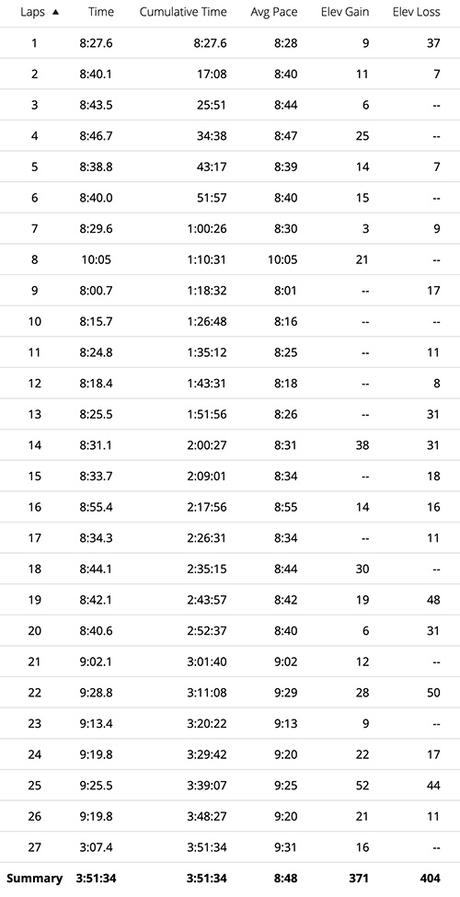I may not have gone where I intended to go, but I think I have ended up where I needed to be.
– Douglas Adams (Author, The Hitchhiker’s Guide to the Galaxy)
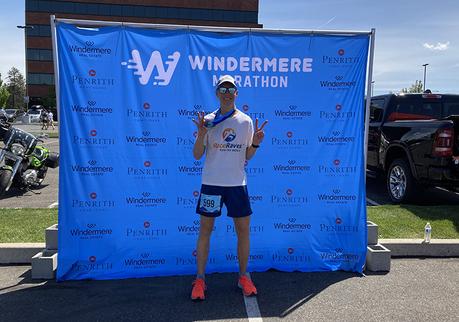
(NOTE: Much of what I discuss here is exclusive to the 2020/2021 pandemic-altered Windermere Marathon course and will not necessarily apply to the “normal” point-to-point course scheduled to return in 2022. With that in mind, read on!)
Beggars, we’re told, can’t be choosers. And sometimes that’s a good thing.
Fourteen months into a global pandemic and two weeks after my second dose of the Moderna SARS-CoV-2 vaccine, I awoke to an oddly welcome and comforting sensation: a body tingling with nervous energy. Not the nervous energy of Covid-induced anxiety so ubiquitous since March 2020, but the fluttering of butterflies that usher in race day. Once reliable companions on marathon mornings, their frequency and intensity had diminished in recent years as my experience and comfort with the distance had grown.
Today, however, was different.
Crossing the street from our hotel in Spokane Valley to the cluster of low-rise office buildings where the start line awaited, I felt almost like a rookie again. After all, running 26.2 miles is an intimidating prospect in the best of circumstances, and not since I’d first covered the distance at Long Beach in 2010 had I gone so long between marathons. My most recent effort had come at the 2020 Little Rock Marathon just a week before races across the U.S. began to cancel en masse, as a novel coronavirus responsible for a severe acute respiratory syndrome in humans single-handedly (or is that single-strandedly?) knocked the world off its axis.
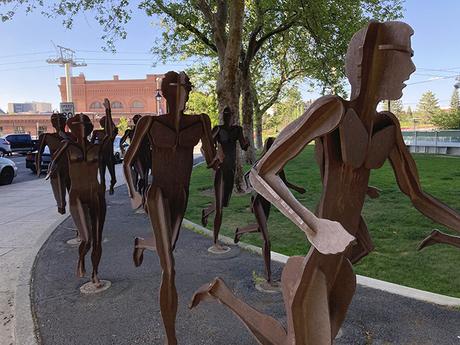
Sure, I’d since run a 50K ultramarathon (and a personal best time) in Kansas seven months earlier, but the marathon is its own beast, one that demands its own mindset and its own approach. So that had been the focus of my training these past several months, as I’d worked my way back into respectable marathon shape. At the same time, today’s Windermere Marathon would itself double as a training run, a much-needed tune-up for my first goal race of the year, the Denali 100K in Alaska five weeks later.
Intermittent cloud cover and the promise of an unseasonably warm day in Spokane greeted Katie and me as we approached the inflatable black-and-blue start arch set up in the parking lot adjacent to the Windermere Real Estate agency. Judging by the sparse crowd, I’d be one of the last marathon starters; with runners starting in socially distanced, self-selected waves every ten minutes, I’d chosen one of the later time slots (7:20–7:30am).
Most of my fellow runners had clearly opted to start earlier, presumably to avoid the worst of the heat; however, as a night owl I knew myself well enough to know I wouldn’t sleep well if I started too early. Besides, it wasn’t like I was out here trying to qualify for Boston. So after a good night’s sleep, I fully intended to keep a cool head and enjoy the morning. Because even before a highly contagious, potentially fatal virus took the civilized world hostage, I’d long since resolved never to take race day for granted.
Bidding Katie farewell, I crossed the start line in a scene eerily reminiscent of Kansas seven months prior—by myself, peeling off my blue surgical mask and stashing it in my pocket for the next several hours. State 32 was underway, in the midst of a global pandemic.
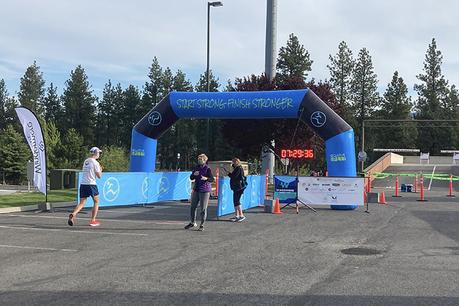
A River Runs Through It
Immediately the course exited the parking lot behind the office complex and headed east on the paved, multi-use Centennial Trail. Leading up to race day I’d targeted a 3hr 45min finish time (8:35/mile), an ambitious yet achievable goal under favorable conditions—the key word being favorable. With the forecast predicting temperatures in the high 70s by noon and the wispy clouds overhead already dispersing, I’d called an audible and dialed back my expectations. While there certainly are days when I’d rather push the pace early and risk flaming out spectacularly, this wasn’t one of them.
To be honest, were this a “normal” year I probably wouldn’t have been running Windermere at all. Eventually, to be sure—Spokane is a beautiful city, and as Pacific Northwest marathons go, Windermere is among the most highly rated on RaceRaves. But with 15 of my remaining 19 states in the Central or Eastern Time Zones, I’d been “saving” Washington (and Idaho, and Utah) for later in my quest to help break up my East Coast travels. Unfortunately, with vaccination in its early stages and SARS-CoV-2 still running roughshod over America, many winter/spring events had opted to either cancel or postpone to later in the year. Meaning my marathon choices for early 2021—and particularly in states where I’d yet to run—were slim pickings.
Negative Split, organizers of the Windermere Marathon as well as the nearby Coeur d’Alene Marathon in Idaho, had been one of the few companies to successfully produce running events in the second half of 2020, with painstaking Covid mitigation protocols in place to protect public health & safety. These mitigation protocols included a redesign of the Windermere Marathon course from its original point-to-point route—highlighted by Gonzaga University and ending near Riverfront Park—to a more pandemic-friendly (though still USATF-certified) double out-and-back starting and finishing at the same parking lot in Spokane Valley. Though suboptimal, this double out-and-back design eliminated the need to shuttle runners to the start, a key benefit in the age of social distancing.
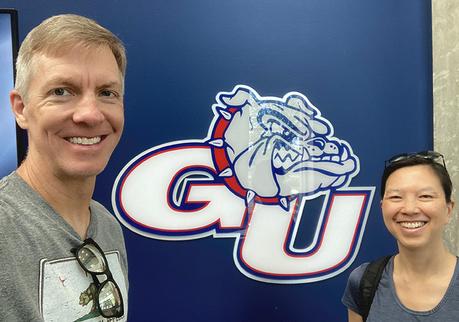
But while I’d have preferred to run the former course, I was wildly grateful to be able to run the latter—and with the opportunity to move ahead with my 50 States quest, I wasn’t about to let perfect be the enemy of great. Besides, we’d still be able to visit the Gonzaga campus, one of Spokane’s main attractions and home to one of the most remarkably successful college basketball programs of the past 25 years.
And true to plan, the Jesuit university had been the focus of our leisurely Saturday afternoon. Gonzaga is a charming, easily walkable campus abutting the Spokane River. This being the offseason and summer semester we couldn’t access the locked McCarthey Athletic Center aka “The Kennel” where the basketball teams play, but we were able to stroll the outer concourse of the arena. Here, tributes to past Bulldogs teams and players lined the walls, including NBA Hall of Famer John Stockton and the 2017 team that lost to North Carolina in the national championship game, just 22 years after the school’s first-ever appearance in the 64-team NCAA tournament—a stunning achievement for a university with only 5,300 undergraduates. (Returning to the NCAA tournament in 2021 as the #1 ranked team in the nation, Gonzaga would suffer its only loss of the season to Baylor in the national championship game to finish 31–1).
Leaving the air-conditioned athletic center and shaded walkways of Gonzaga, we’d driven to sun-drenched Riverfront Park, the recently renovated centerpiece of Spokane and a larger, more sprawling version of The Gathering Place in Tulsa. The legacy of the 1974 World’s Fair, Riverfront Park is dominated by Upper and Lower Spokane Falls, the beating heart of the park whose awesome power has been harnessed to generate electricity for well over a century. Further along the riverbank graceful Canadian geese floated, strutted, and honked, comporting themselves like local lords overseeing their fiefdoms. And a short walk from the falls we visited the perennially popular Garbage Goat, an inanimate metal mammal which, thanks to an internal vacuum, ingests scraps of trash that are “fed” to it, thereby doing its part to keep the park clean. Quirky, creative, and just the sort of thing I hope to find when exploring a new city.
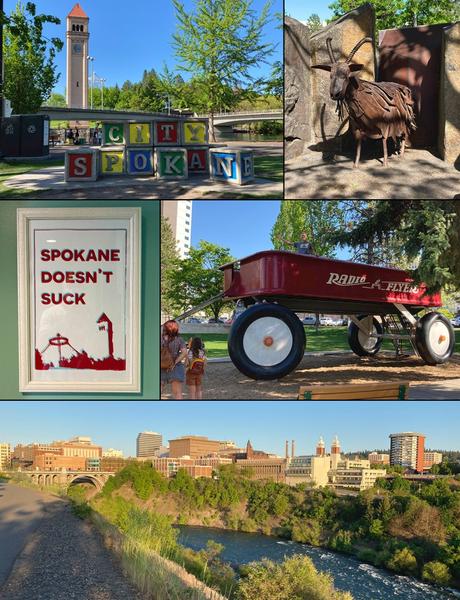
Now, running some 13 miles east of Riverfront Park, I followed the Spokane River on its eastward journey while enjoying the peaceful, tree-lined trail that suddenly felt far removed from office buildings and other signs of civilization. A hallmark of many Washington marathons is their proximity to a body of water, and Windermere is no exception; the fast-flowing river would remain a constant and soothing source of companionship throughout the morning.
“LET’S GO OUT WITH A BANG!” read a message chalked onto the trail in the opening miles, followed by an even less understated “BANG! BANG!” in chalk a few steps later. As if on cue, I glanced up to see two quails dart across the path between runners, their rapid gliding movements making me smile.
Flanked by trees on our right and the river on our left, the first five miles (aka miles 11–16 on the return trip) were the most scenic and shaded of the day, with towering evergreens bending in the breeze as though welcoming us to the Pacific Northwest. Distant homes set back from the trail came into view as we approached the Liberty Lake neighborhood, in normal years the start area for the marathon.
Often at races I’ll find myself inadvertently eavesdropping on other runners’ conversations. Such was the case at Windermere, and it occurred to me that while some of these conversations can be encouraging, many of them instead follow a different progression—one person explaining to their running mate a conversation that makes the speaker sound cool, calm and collected while depicting the other side as clueless, unreasonable and/or just plain unhinged. The brief snippets I hear from passing cyclists on my training runs tend to be even more angsty, though maybe it just sounds that way since they speak louder to be heard. At any rate, small wonder Americans have so much trouble communicating these days when the other person is always in the wrong.
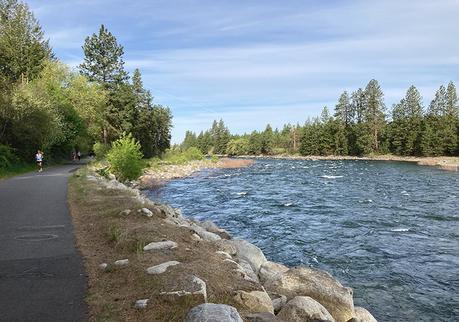
Running east into the sun, a slight headwind kept things cool as we passed the half marathoners’ turnaround. Suddenly the pack thinned significantly and the marathon became a lonely prospect, as I found myself alone with only two other runners visible in the distance. Certainly I’d expected that most of the runners here would be half marathoners, though not quite this many. It didn’t help that most of my fellow marathoners had chosen earlier start times.
To my right, the zoom of high-speed traffic on I-90 offered a transient distraction. Too transient as it turned out, because soon my stomach began to fuss, and by the time I reached the mile 8 turnaround, I had little choice but to accede to its demands, shameless bioterrorist that it is. Passing my first Katie sighting without slowing, I headed straight into the porta-potty standing just beyond the aid station table, a stone’s throw from the Idaho border.
Exiting a minute later, I grabbed a bottle of water from the table, took a few sips and—with a “hi” and “bye” to Katie—headed back the way I’d come. Instantly I felt better with my stomach settled and the sun at my back, and my stride relaxed as I once again passed the half marathoners’ turnaround and rejoined the flow of human traffic. A stretch of roughly 12 miles on the Centennial Trail lay between me and the next turnaround, and I focused on settling back into a rhythm while staying mentally sharp.
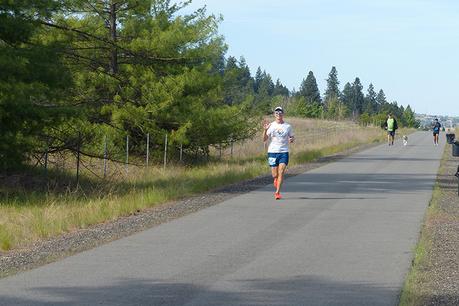
Turnaround is Fair Play
Bemoaning the minute or so I’d lost to my pitstop at the mile 8 turnaround, it occurred to me that maybe my stomach wouldn’t hold me hostage on race day if I were to train it more appropriately, for example by doing my longer training runs at the same time of day I run my races, i.e. in the early morning. In this vein, many runners while training for the Boston Marathon schedule their longer training runs for Mondays rather than weekends to prepare their bodies to run on Patriots’ Day, aka Marathon Monday. Thing is, as a night owl the evening hours are my most productive, and many of my runs—including my longer weekend runs—happen in the afternoon. So while I’m unlikely to greet the sunrise on a training run anytime soon, I do need to give serious consideration to shifting my schedule so as to make it a bit more morning friendly. Easier said than done, though, since I treasure my evening quiet time free of the usual 9-to-5 distractions.
I passed a female runner wearing a shirt that read “Thanks science! I’m vaccinated.” Yes and yes, I thought, mentally fist-bumping her as we headed in opposite directions.
Not surprisingly, spectators along the course were few and far between; those who did show, however, were boisterous in their support. This was especially true on our second visit to Liberty Lake, where I appreciated the spirited cheers coming as they did immediately after one of the few uphill jags of the day. One fellow even complimented me on my bright orange Nikes. And enviously I overheard a mother tell her sign-wielding kids, “Ok, let’s go get donuts!” Can I come?
The day had warmed perceptibly as we returned to the shade in mile 14. As a silver lining in the near-cloudless sky, the low humidity in Spokane meant we wouldn’t be battling the twin terrors of heat and humidity, as I had for example at the 2016 Hatfield McCoy Marathon in Kentucky. Heat may be uncomfortable, but high humidity’s a stone cold killa.
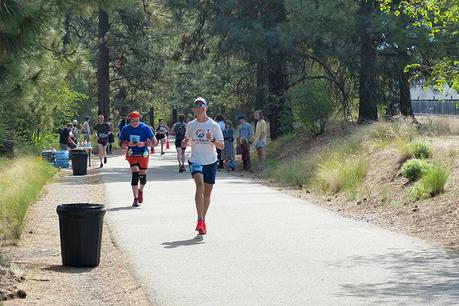
Focusing on my stride, I passed a number of runners before reaching the turn-in to the finish line—the finish line for the half marathoners that is, and mile 16 for the rest of us. This was another design quirk unique to this year’s reimagined course, but still it felt like a punch to the gut to be running right by the finish line where the voice of the PA announcer sounded so close, you could easily imagine hearing your own name waft by on the breeze. Unfortunately, I still had ten miles to go before I’d earn that opportunity—which, on the bright side, was better than at Marshall where we’d run another 11 miles after passing the finish line the first time.
With the half marathoners out of the picture, the caravan of runners thinned considerably and I was rewarded for my efforts with my second Katie sighting. Quickly I took a few swigs of water from the bottle in her outstretched hand, then traded her for my first bottle of Maurten and pushed ahead. Every second spent not moving forward was another second the sun continued to climb higher in the sky.
Mile after mile, the Spokane River flowed serenely alongside, now on my right side as I set my sights on the second turnaround. This course reminded me of another Pacific Northwest race I’d run back in 2017, the Eugene Marathon in Oregon where we’d run several miles along the Willamette River on a similarly pleasant, tree-lined trail.
The only spectator sign I recall—because it was the only one that grabbed my attention—greeted us ominously in mile 17:
“DON’T LET THE MIND QUIT—THE BODY WON’T UNTIL IT DIES.”
Oh my, I thought, is this really what passes for inspiration in Spokane? While I got the gist of the message (I think), this sounded more like either the lyrics to an Alice in Chains song or the kind of muddled high school coach-speak I’d heard growing up in Texas athletics, the type of “motivation” often followed by an out-of-shape teammate projectile vomiting during offseason conditioning drills. In that moment, I’d have settled for more traditional encouragement like “This is an awful lot of work for a green banana” or “You’re running better than the government!”
Mile 20 offered a change of pace as the Centennial Trail crossed over the Spokane River, positioning the river to our left for the final mile leading to the mile 21 turnaround. As we continued to run away from the finish line, I fought back physical and mental fatigue while trying to will the turnaround into view. Surely we should have reached it by now?
Just when I was starting to lose patience, we reached the trail’s end and turned onto a narrow residential road where Katie greeted me at the top of a brief but nasty hill: “Nice job, the turnaround is just up ahead.” Arrgh. Shuffling ahead a few more yards, I reached the turnaround alongside the mile 21 marker, reversing direction before making one last stop to hydrate and gather my wits.
Feeling unsteady on my feet—that’ll happen after running 21 miles—I took a few more swallows of water and mumbled orders hurriedly at poor Katie as she juggled bottles and tried to anticipate my needs. Hold this! Open that! No, that! Lucky for me, she’s always a good sport and the best crew on race day. I took one quick sip of 5-hour Energy, being careful not to elevate my pulse rate too much more in the rising heat. Then, trading for a second bottle of Maurten, I thanked her and retraced my steps, knowing that in these last five miles a struggle awaited.
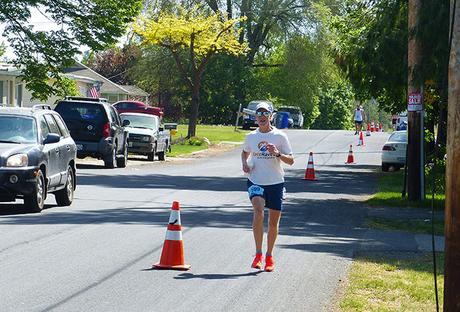
Hot on the Trail
By the time I reached mile 23, I needed all my focus just to keep pushing forward, and I scarcely glanced up to notice the sparkling view of the Spokane River as the trail again crossed to the other side. With limited shade along this stretch and the late morning sun approaching its zenith, the same headwind I’d begrudged earlier now became a key ally in my fight to stay cool.
Somehow—whether by sheer willpower, diligent training, super-springy Nikes or (more likely) a combination of the three—I was able to maintain forward momentum despite the intensifying sun and a couple of wicked uphill jags. In fact, my 9+ minute-per-mile pace felt downright Kenyan compared to many of my fellow marathoners who were now walking. Ignoring my own fatigue, I continued to pick off runners as we headed toward home. And I was delighted to discover that, leaden quads notwithstanding, here in my first race of 2021 and my first marathon in 14+ months, everything actually felt pretty damn good. And that in itself was a victory.
“QUIT” was the only word I saw as I glanced over at the now-familiar, unmanned spectator sign in mile 25. A cyclist approached and as he did, I realized it was Race Director Ryan. “You need anything? Water? Gatorade?” he asked. Shaking my head I muttered, “Thanks, Ryan” in a low voice I’m quite sure he didn’t hear. Then I forged ahead, feeling the gravitational pull of the finish line, which I resisted just long enough to snap one last picture of a curious, covered bridge-type structure in mile 26. I couldn’t recall ever stopping for a photo this late in a race, since usually I’m laser-focused on finishing and too exhausted to care about anything else.
My Garmin chimed for the 26th time and suddenly my legs felt very heavy, as though forgetting we still had 0.2 miles to go. Lifting my eyes from the trail, I saw the final turn ahead as the cheers of several volunteers and Katie welcomed me back. Making the turn I’d so envied ten miles earlier, I climbed the last few yards back to the parking lot outside the Windermere Real Estate offices and jubilantly crossed under the bright blue finish arch, stopping the clock in a time of 3:51:25. And for the first time in memory, Katie would be the person to hang the finisher’s medal around my neck, after I’d received the medal at packet pickup (another pandemic workaround) but waited superstitiously until this moment to unveil it.
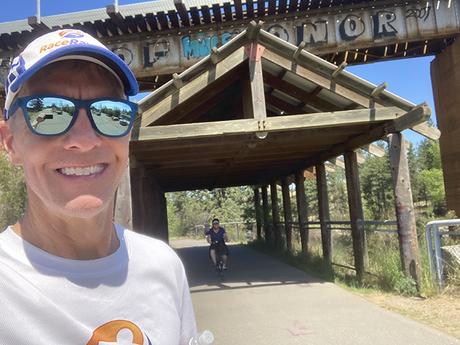
Though not the 3:45:00 I’d been hoping to chase in cooler weather, given the unseasonal heat I was satisfied with a respectable sub-4 hour showing. And I credit my carbon fiber-plated Nikes with providing a (literal) spring in my step that kept my legs fresher for longer on race day. I run enough marathons—and am just enough of a shoe nerd—that carbon fiber-plated technology is worth the investment. And I’m for any healthy, legal advantage I can get on race day—after all, my biggest competitor will always be myself.
Normally staged at the festive finish line near Riverfront Park, the post-race gathering this year was held in the start/finish parking lot and was understandably scaled back to avoid crowds and limit high-contact areas. Big thanks to Meltz and Cosmic Cowboy Grill for providing post-race food options, which as usual my disinterested stomach refused to consider.
I compared notes with a group of running friends who were using Windermere to train for an upcoming 50-miler in Montana. And I made a point to congratulate 64-year-old Carolann from Florida who, according to the PA announcer, had just finished her 50 States quest here in Spokane. Admittedly, I felt a pang of sympathy for her at having to conclude such a long and arduous journey in Covid-contorted conditions. Even so, the global context in no way diminished her remarkable achievement, and I’m glad I could be there to acknowledge it.

Then Katie and I slowly made our way back across the street to the Hampton Inn & Suites for a shower before dining on our way to the airport at the Yards Bruncheon in Kendall Yards near Riverfront Park. Unfortunately, there are no nonstop flights from Spokane to Los Angeles on Southwest Airlines, and so that night was a long one as we endured a layover in one of my (least) favorite cities, Las Vegas. On the second leg of the trip my usual post-marathon congestion-with-cough kicked in, and though I tried to clear my throat quietly behind my mask, I’d imagine I earned a few sidelong glances from my fellow passengers. No worries, I’m vaccinated!
(Have I mentioned vaccines may be the single greatest scientific discovery in the history of mankind? Thanks, science!)
This (and last) year’s Windermere Marathon was unfortunately constrained by a global pandemic not of its making and out of its control. That said, Windermere was one of the few races to actually take place during the pandemic, and the fact it happened at all is a testament to the team at Negative Split, who bent over backwards to implement one of the nation’s first Covid mitigation protocols to protect the health and safety of their runners. Although Windermere’s downhill, point-to-point marathon course and post-race party in Downtown Spokane were necessary casualties of the pandemic, still I’d rate the weekend an unqualified success. And I’ve no doubt that in a “normal” year, Windermere would make a terrific choice for 50 Staters and anyone seeking a Pacific Northwest marathon.
So while the pandemic may have derailed everyone’s best-laid plans and prompted me to pull the trigger on Washington ahead of schedule, it all worked out in the end as I added another puzzle piece (and state 32) to the four-dimensional game of real-world Tetris that is my 50 States quest. Just as in so many other aspects of life, adaptability is key to 50 States success, and so sometimes beggars can’t be choosers—though most people say that like it’s a bad thing.
But I beg to differ.
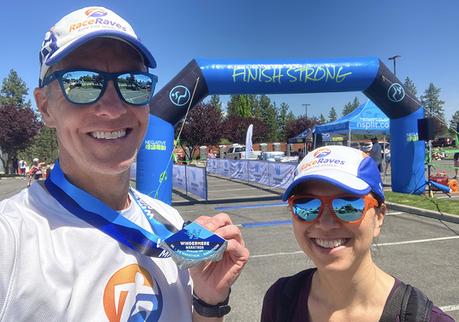
BOTTOM LINE: Named for a local real estate agency and its eponymous foundation dedicated to helping low-income and homeless families, Windermere is a relaxed, picturesque marathon that will be even better in the post- (as it was in the pre-)Covid era. This is largely because 2022 is expected to welcome the return of the original point-to-point course, which includes 11-ish miles of this year’s route plus Gonzaga University and a festive finish near Riverfront Park (in contrast to this year’s necessarily low-key start & finish in the parking lot of the Windermere offices in Spokane Valley). That said, this year the Negative Split team did a terrific job turning gators into Gatorade with a pleasant, well-supported event that consisted of two out-and-backs on the paved Centennial Trail along the Spokane River. I’m typically no fan of out-and-backs, and especially in the later miles when you can clearly see the fatigue on the faces and in the body language of your fellow runners who are several miles ahead of you. Unfortunately, a global pandemic tends to limit your options as a runner or race director. And the river is a beautiful centerpiece for the race, even if the non-river side of the course doesn’t always live up to the same scenic standard.
Spokane itself is a charming city with two main highlights for the weekend tourist: Gonzaga University, a small Jesuit university that’s paradoxically home to one of the premier men’s college basketball programs of the past 25 years, and Riverfront Park, which is the legacy of the 1974 World’s Fair and the focal point of downtown Spokane. Riverfront Park feels like a more sprawling version of Tulsa’s Gathering Place but with a nicer river frequented by gaggles of elegant Canada geese. And while the park is the emerald jewel of the city, its beating heart is mighty Spokane Falls, whose power has been harnessed to generate electricity for well over a century. One of the joys of racing in Washington is that many (if not most) of the state’s marathons & half marathons run within view of an impressive body of water, and Windermere’s course alongside the fast-flowing Spokane River is no exception.
PRODUCTION: Windermere (along with Negative Split’s other marathon in nearby Coeur d’Alene) was one of the few marathons held in the U.S. in 2020, albeit with significant changes, and it was clear from this year’s production that this was not the team’s first pandemic rodeo. From the quick & easy outdoor packet pickup at the local Fleet Feet store (finisher medal included) to the rolling start line to the scaled-back post-race gathering, race weekend was seamless if subdued. The entire process gave me a renewed appreciation—and frustration—for the fact that given the chance to implement similar Covid mitigation strategies based on the science of viral transmission, more events could have safely and responsibly moved forward with reduced field sizes last year.
Out-and-back courses typically aren’t my jam, but this year it couldn’t be helped, and more than anything I think most of us were grateful for the chance to be healthy and racing again. The DIY aid stations were an afterthought for me since I only paused at the mile 8 turnaround to grab a bottle of water, but Race Director Ryan did pass me on a bike in the later (warmer) miles asking if I needed water, Gatorade or anything else, so a shout-out of gratitude to him. More than anything, I appreciated that mile markers were taped to the trail throughout the race, and especially in the closing miles when mentally I celebrate every mile marker as a mini-finish line. Plus, race photos were free, though for whatever reason no photos of me were available—not a big deal since Katie captured plenty along the course.
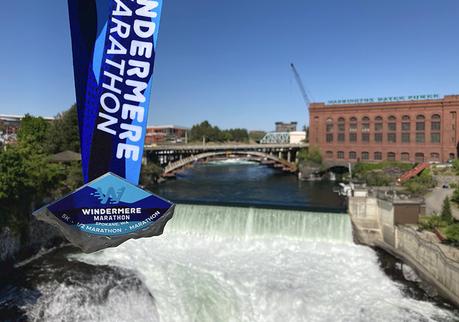
SWAG: The multi-blue finisher medal is brightly colored and nice enough, though as one-third of a three-piece interlocking medal for runners of Negative Split’s Run the PNW Series (comprising Windermere, The Split Half Marathon and Coeur d’Alene), it’s wedge-shaped and visually less satisfying than a comparable standalone medal. That said, I can imagine the three-piece medal in its entirety would be a lovely keepsake. Fortunately, the long-sleeve black tech shirt is a keeper—I know some folks aren’t fans of black and especially during the summer months, but having grown up an unabashed fan of heavy metal music, for better or worse I still have a soft spot for black clothing, even as my closet steadily fills with race apparel.
Updated 50 States Map:
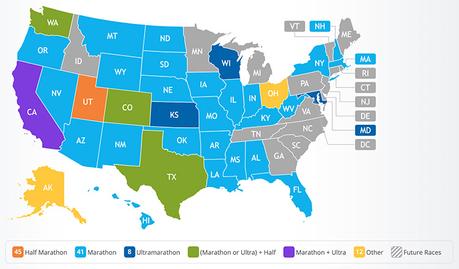
RaceRaves rating:
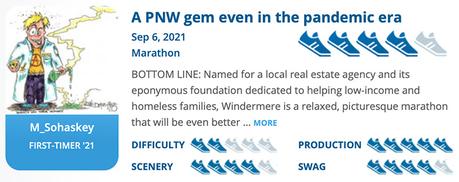
FINAL STATS:
May 16, 2021 (start time 7:29 am, sunrise 5:09 am)
26.33 miles in Spokane, Washington (state 32 of 50)
Finish time & pace: 3:51:35 (first time running the Windermere Marathon), 8:48/mile
Finish place: 42 overall, 4/12 in M(50-54) age group
Number of finishers: 200 (105 men, 95 women)
Race weather: cool & sunny (57°F) at the start, warm & sunny (75°F) at the finish
Elevation change (Garmin Connect): 371 ft gain, 404 ft loss
Elevation min, max: 1,909 ft, 2,047 ft
